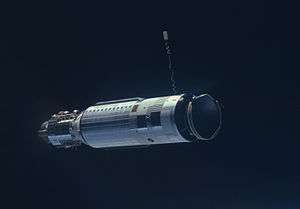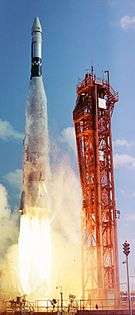Agena target vehicle



The Agena Target Vehicle (ATV) was an unmanned spacecraft used by NASA during its Gemini program to develop and practice orbital space rendezvous and docking techniques and to perform large orbital changes, in preparation for the Apollo program lunar missions.[1]
Operations

Each ATV consisted of an Agena-D derivative upper rocket stage built by Lockheed and a docking adapter built by McDonnell. The Agena was launched from Cape Canaveral Air Force Station Launch Complex 14 on top of an Atlas booster built by the Convair division of General Dynamics. The Agena first burn would occur shortly after shroud jettison and separation from the Atlas over the Atlantic Ocean. Over Ascension Island, a second burn would place the Agena into a low circular orbit.[1]
The McDonnell Gemini spacecraft would then be launched from Launch Complex 19, as soon as 90 minutes later. Both countdowns would proceed in parallel and required close synchronization. The Gemini would rendezvous and dock with the Agena as soon as Gemini's first orbit toward the end of the program.[1]
The Gemini astronauts would then fly the combined spacecraft in a stabilized mode and perform a number of experiments:
- Using the Agena's attitude control system to stabilize the combination, which saved the Gemini's propellants
- Extra-vehicular activity to perform practice work on a tool panel. This required installing handrails on later flights to prevent excessive astronaut exertion.
- Refiring the Agena engine to raise the spacecraft's apogee. Gemini 11 reached a record of 739.2 nautical miles (1,369.0 km). The modified Bell 8247 engine was qualified for up to 15 restarts.[1]
- Undocking, unreeling a 50-foot (15 m) nylon tether between the capsule and the Agena and flying in a "dumbbell" configuration with the Agena below the astronauts, to check the gravitational effect on the formation stability in uncontrolled mode. This technique is now known as Gravity-gradient stabilization.
- Using a similar tether and a few thruster bursts to rotate the two craft around each other as an early test of artificial gravity.
- After rendezvous with its own ATV, Gemini 10 performed a second rendezvous with the ATV from Gemini 8.
After the Gemini capsule separated for the last time, the Agena remained in orbit for a short time and was used to verify the command system.
The first Gemini-Agena Target Vehicle (GATV) was launched on October 25, 1965 while the Gemini 6 astronauts were waiting on the pad. While the Atlas performed normally, the Agena's engine exploded during orbital injection. Since the rendezvous and docking was the primary objective, the Gemini 6 mission was scrubbed, and replaced with the alternate mission Gemini 6A, which rendezvoused (but could not dock) with Gemini 7 in December.
An investigation into the failure concluded that it was most likely caused by design modifications to the GATV versus a standard Agena D stage. The Agena D was designed to have its engine restarted just once while the GATV would need to be restarted five times. While a standard Agena D pumped oxidizer into the combustion chamber first and then followed with the fuel, the GATV was modified to do the reverse because the normal start method had a tendency to leak oxidizer. While this would not be a problem for the Agena D with its single restart, the multi-restart GATV would eventually lose all of its oxidizer before the stage's operating life (which would last weeks instead of hours) could be completed. Unfortunately, pumping the fuel into the combustion chamber first caused the engine to backfire and rupture from mechanical shock. It was found out that Lockheed-Martin engineers did not properly test the GATV to root out this problem (it had been tested at a simulated altitude of 21 miles up when actual Agena engine start would occur at around 75 miles up). The solution to the problem was switching back to the normal oxidizer-first engine start and also testing the GATV in appropriate conditions. Bell Aerosystems, the manufacturer of the Agena's engine, were also instructed to perform further ground-level tests.
Augmented Target Docking Adapter

After the failure of the first GATV, McDonnell-Douglas developed a backup vehicle in case this situation should happen again. This was the Augmented Target Docking Adaptor, a dummy Agena stage with a docking collar, but no propulsion system. A few questions were raised about the compatibility of the ATDA with the Atlas booster, since it had much lower mass than the GATV, potentially throwing off the launch vehicle's aerodynamics and calibrated settings. However, Convair assured McDonnell-Douglas that it would pose no technical issues with the booster.
On May 17, 1966, Gemini 9 astronauts Tom Stafford and Eugene Cernan were sitting on the pad awaiting the launch of their GATV. But once again, things went awry. The Atlas lifted smoothly into a cloudy sky, vanishing from view around T+50 seconds. Shortly before Booster Engine Cutoff (BECO) was supposed to occur, the guidance control officer announced that he had lost contact with the booster. Telemetry indicated that vernier and sustainer cutoff occurred at T+300 seconds and Agena staging had taken place. The Agena continued transmitting signals until T+436 seconds, when all telemetry ceased.
Meanwhile, hidden behind cloud cover, the Atlas's right booster engine gimbaled hard to right at around T+120 seconds. The launch vehicle flipped 216 degrees around and began flying back towards Cape Canaveral, and in doing so had rotated into a position where it was impossible for ground guidance to lock on. Radar stations in the Bahamas indicated that it was heading north and descending. Atlas engine cutoff and Agena staging occurred on schedule, and both vehicles plunged into the Atlantic Ocean. Telemetry indicated that a short-to-ground occurred in the circuit for the servoamplifier output command signal, which may have been caused by cryogenic leakage in the thrust section.
While Convair accepted responsibility for the launch failure, Lockheed engineers expressed concern about telemetry data that indicated a servo failure in the Agena, leading to doubts as to whether the stage would have still operated properly if the Atlas hadn't malfunctioned. However, the real cause quickly surfaced when the Air Force released film taken by tracking cameras at Melbourne Beach, Florida, which showed the Atlas pitching over and plummeting downward. Lockheed breathed a sigh of relief when they realized that the servo malfunction was merely due to the Agena passing through the Atlas's ionized exhaust trail.
An ATDA was launched on June 1, 1966, but the shroud that protected the docking adaptor during launch failed to jettison, due to lanyards being incorrectly secured with adhesive tape. Gemini 9A was launched on June 3, and when in orbit, the crew observed that the shroud of the ATDA had partially opened and was described by Stafford as "looking like an angry alligator". Docking was not possible, but the rendezvous maneuver was practiced instead.[2][3][4][5]
Flight statistics
| Target | Gemini mission | Launched | Reentered | NSSDC ID | Mass | Comments |
|---|---|---|---|---|---|---|
| GATV-5002 | Gemini 6 | October 25, 1965 15:00:04 UTC |
October 25, 1965 15:06:20 UTC |
GEM6T | 7,190 pounds (3,260 kg) | Atlas-Agena exploded during launch. Gemini 6A achieved first rendezvous with Gemini 7 instead. |
| GATV-5003 | Gemini 8 | March 16, 1966 15:00:03 UTC |
September 15, 1967 | 1966-019A | 7,000 pounds (3,200 kg) | Achieved first docking, but mission soon aborted due to stuck Gemini thruster. ATV later used as secondary target on Gemini 10. |
| GATV-5004 | Gemini 9 | May 17, 1966 15:12:00 UTC |
May 17, 1966 15:19:00 UTC |
GEM9TA | 7,170 pounds (3,250 kg) | Failed to orbit. |
| ATDA No. 02186 | Gemini 9A | June 1, 1966 15:00:02 UTC |
June 11, 1966 | 1966-046A | 1,750 pounds (790 kg) | No Agena rocket. Successful rendezvous, but no docking due to shroud separation failure. |
| GATV-5005 | Gemini 10 | July 18, 1966 20:39:46 UTC |
December 29, 1966 | 1966-065A | 7,000 pounds (3,200 kg) | Boosted Gemini 10 to 412-nautical-mile (763 km) apogee. |
| GATV-5006 | Gemini 11 | September 12, 1966 13:05:01 UTC |
December 30, 1966 | 1966-080A | 7,000 pounds (3,200 kg) | Boosted Gemini 11 to record 739.2-nautical-mile (1,369.0 km) apogee. First demonstration of artificial gravity created in microgravity. |
| GATV-5001A | Gemini 12 | November 11, 1966 19:07:58 UTC |
December 23, 1966 | 1966-103A | 7,000 pounds (3,200 kg) | No apogee boost due to defective Agena engine. Performed tether experiment. |
See also
References
- 1 2 3 4 Lockheed Missiles & Space Company (1972-02-25). "Shuttle/Agena study. Volume 1: Executive summary". NASA.
- ↑ "Gemini 9A" (Version 4.0.25 ed.). NASA. August 16, 2013. Retrieved October 30, 2013.
- ↑ "Gemini 9 Target A" (Version 4.0.25 ed.). NASA. August 16, 2013.
- ↑ "McDonnell ATDA". Encyclopedia Astronautica. Retrieved June 6, 2012.
- ↑ "Gemini 9 Target B" (Version 4.0.25 ed.). NASA. August 16, 2013. Retrieved October 30, 2013.
![]() This article incorporates public domain material from websites or documents of the National Aeronautics and Space Administration.
This article incorporates public domain material from websites or documents of the National Aeronautics and Space Administration.
External links
- Gemini 6/Agena target vehicle 5002 systems test evaluation (PDF) December 1965
- Gemini 6 Agena Target vehicle
- Gemini 8 Docks with Agena Video
- On the Shoulders of Titans, Project Gemini, NASA history

